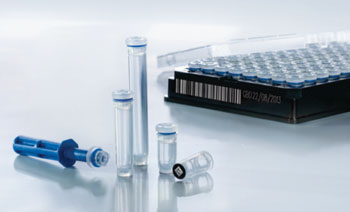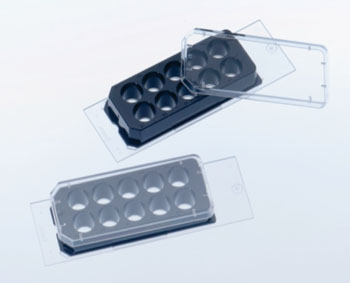Greiner Bio-One to Introduce Innovative Lab Products at Analytica
|
By LabMedica International staff writers Posted on 15 Apr 2014 |

Image: New ThinCert cell culture inserts coated with collagen type I (Photo courtesy of Greiner Bio-One).

Image: New Cryo.s biobank tubes for high-throughput sample storage in automated storage systems (Photo courtesy of Greiner Bio-One).

Image: CELLview slide with a removable housing that divides the slide into ten round compartments (Photo courtesy of Greiner Bio-One).
A company that counts among its customers the world’s largest labs, biotech, and pharmaceutical companies will introduce six new products at the analytica trade fair, in May 2014.
Greiner Bio-One (Frickenhausen, Germany) will showcase six innovative new products at analytica 2014, which will be held from May 10–13, in Munich (Germany). The Austro-German company, a technology partner for the diagnostic and pharmaceutical industries, is demonstrating its commitment to research and development.
With the new Cryo.s biobank tubes, Greiner Bio-One, which has been developing products for cryogenic storage for 30 years, is expanding its product portfolio to include a solution for high-throughput sample storage in automated storage systems. A new box in the standard 133 mm square format for the existing 1 mL, 2 mL and 4 mL Cryo.s freezing vials is also being unveiled at analytica, offering space for 81 Cryo.s vials. Openings on the bottom of the box enable a scanner to read the datamatrix codes without having to remove the vials.
Two innovations for the microscopy sector will be exhibited by Greiner Bio-One. One of them is the 384 well Screenstar microplates that can be used for high-throughput and high-content screening and high-resolution microscopy. The other solution for microscopy is a development from the Cellview product family––the Cellview slide. This is equipped with a removable housing that divides the slide into ten round compartments. To start with, ten independent cell cultures can be carried out for processing in a single operation after removing the housing.
In the field of cell cultivation, Greiner Bio-One is introducing the new ThinCert cell culture inserts coated with collagen type I at Analytica 2014. The additional coating with native collagen type I accelerates growth and differentiation processes several times over.
To simplify users' liquid handling, Greiner Bio-One has developed new colored inserts for Sapphire pipette tip boxes. The customized coloring is designed to help users identify more quickly which size of pipette tips is held by a particular box holds.
"Research and development are extremely important to us as a development-driven medium-sized enterprise," said Heinz Schmid, managing director of Greiner Bio-One GmbH. "As the leading trade fair for laboratory technology, analysis and biotechnology, analytica is a key platform for us to present our new products to customers and other interested parties."
Related Links:
Greiner Bio-One
Analytica
Greiner Bio-One (Frickenhausen, Germany) will showcase six innovative new products at analytica 2014, which will be held from May 10–13, in Munich (Germany). The Austro-German company, a technology partner for the diagnostic and pharmaceutical industries, is demonstrating its commitment to research and development.
With the new Cryo.s biobank tubes, Greiner Bio-One, which has been developing products for cryogenic storage for 30 years, is expanding its product portfolio to include a solution for high-throughput sample storage in automated storage systems. A new box in the standard 133 mm square format for the existing 1 mL, 2 mL and 4 mL Cryo.s freezing vials is also being unveiled at analytica, offering space for 81 Cryo.s vials. Openings on the bottom of the box enable a scanner to read the datamatrix codes without having to remove the vials.
Two innovations for the microscopy sector will be exhibited by Greiner Bio-One. One of them is the 384 well Screenstar microplates that can be used for high-throughput and high-content screening and high-resolution microscopy. The other solution for microscopy is a development from the Cellview product family––the Cellview slide. This is equipped with a removable housing that divides the slide into ten round compartments. To start with, ten independent cell cultures can be carried out for processing in a single operation after removing the housing.
In the field of cell cultivation, Greiner Bio-One is introducing the new ThinCert cell culture inserts coated with collagen type I at Analytica 2014. The additional coating with native collagen type I accelerates growth and differentiation processes several times over.
To simplify users' liquid handling, Greiner Bio-One has developed new colored inserts for Sapphire pipette tip boxes. The customized coloring is designed to help users identify more quickly which size of pipette tips is held by a particular box holds.
"Research and development are extremely important to us as a development-driven medium-sized enterprise," said Heinz Schmid, managing director of Greiner Bio-One GmbH. "As the leading trade fair for laboratory technology, analysis and biotechnology, analytica is a key platform for us to present our new products to customers and other interested parties."
Related Links:
Greiner Bio-One
Analytica
Latest Technology News
- Disposable Microchip Technology Could Selectively Detect HIV in Whole Blood Samples
- Pain-On-A-Chip Microfluidic Device Determines Types of Chronic Pain from Blood Samples
- Innovative, Label-Free Ratiometric Fluorosensor Enables More Sensitive Viral RNA Detection
- Smartphones Could Diagnose Diseases Using Infrared Scans
- Novel Sensor Technology to Enable Early Diagnoses of Metabolic and Cardiovascular Disorders
- 3D Printing Breakthrough Enables Large Scale Development of Tiny Microfluidic Devices
- POC Paper-Based Sensor Platform to Transform Cardiac Diagnostics
- Study Explores Impact of POC Testing on Future of Diagnostics
- Low-Cost, Fast Response Sensor Enables Early and Accurate Detection of Lung Cancer
- Nanotechnology For Cervical Cancer Diagnosis Could Replace Invasive Pap Smears
- Lab-On-Chip Platform to Expedite Cancer Diagnoses
- Biosensing Platform Simultaneously Detects Vitamin C and SARS-CoV-2
- New Lens Method Analyzes Tears for Early Disease Detection
- FET-Based Sensors Pave Way for Portable Diagnostic Devices Capable of Detecting Multiple Diseases
- Paper-Based Biosensor System to Detect Glucose Using Sweat Could Revolutionize Diabetes Management
- First AI-Powered Blood Test Identifies Patients in Earliest Stage of Breast Cancer
Channels
Clinical Chemistry
view channel
‘Brilliantly Luminous’ Nanoscale Chemical Tool to Improve Disease Detection
Thousands of commercially available glowing molecules known as fluorophores are commonly used in medical imaging, disease detection, biomarker tagging, and chemical analysis. They are also integral in... Read more
Low-Cost Portable Screening Test to Transform Kidney Disease Detection
Millions of individuals suffer from kidney disease, which often remains undiagnosed until it has reached a critical stage. This silent epidemic not only diminishes the quality of life for those affected... Read more
New Method Uses Pulsed Infrared Light to Find Cancer's 'Fingerprints' In Blood Plasma
Cancer diagnoses have traditionally relied on invasive or time-consuming procedures like tissue biopsies. Now, new research published in ACS Central Science introduces a method that utilizes pulsed infrared... Read moreMolecular Diagnostics
view channel
New Genetic Tool Analyzes Umbilical Cord Blood to Predict Future Disease
Children are experiencing metabolic problems at increasingly younger ages, placing them at higher risk for serious health issues later in life. There is a growing need to identify this risk from birth... Read more
Spinal Fluid Biomarker for Parkinson’s Disease Offers Early and Accurate Diagnosis
Parkinson’s disease is a neurodegenerative condition typically diagnosed at an advanced stage based on clinical symptoms, primarily motor disorders. However, by this time, the brain has already undergone... Read moreHematology
view channel
New Scoring System Predicts Risk of Developing Cancer from Common Blood Disorder
Clonal cytopenia of undetermined significance (CCUS) is a blood disorder commonly found in older adults, characterized by mutations in blood cells and a low blood count, but without any obvious cause or... Read more
Non-Invasive Prenatal Test for Fetal RhD Status Demonstrates 100% Accuracy
In the United States, approximately 15% of pregnant individuals are RhD-negative. However, in about 40% of these cases, the fetus is also RhD-negative, making the administration of RhoGAM unnecessary.... Read moreImmunology
view channel
Stem Cell Test Predicts Treatment Outcome for Patients with Platinum-Resistant Ovarian Cancer
Epithelial ovarian cancer frequently responds to chemotherapy initially, but eventually, the tumor develops resistance to the therapy, leading to regrowth. This resistance is partially due to the activation... Read more
Machine Learning-Enabled Blood Test Predicts Immunotherapy Response in Lymphoma Patients
Chimeric antigen receptor (CAR) T-cell therapy has emerged as one of the most promising recent developments in the treatment of blood cancers. However, over half of non-Hodgkin lymphoma (NHL) patients... Read moreMicrobiology
view channel
Handheld Device Delivers Low-Cost TB Results in Less Than One Hour
Tuberculosis (TB) remains the deadliest infectious disease globally, affecting an estimated 10 million people annually. In 2021, about 4.2 million TB cases went undiagnosed or unreported, mainly due to... Read more
New AI-Based Method Improves Diagnosis of Drug-Resistant Infections
Drug-resistant infections, particularly those caused by deadly bacteria like tuberculosis and staphylococcus, are rapidly emerging as a global health emergency. These infections are more difficult to treat,... Read more
Breakthrough Diagnostic Technology Identifies Bacterial Infections with Almost 100% Accuracy within Three Hours
Rapid and precise identification of pathogenic microbes in patient samples is essential for the effective treatment of acute infectious diseases, such as sepsis. The fluorescence in situ hybridization... Read morePathology
view channel
Sensitive and Specific DUB Enzyme Assay Kits Require Minimal Setup Without Substrate Preparation
Ubiquitination and deubiquitination are two important physiological processes in the ubiquitin-proteasome system, responsible for protein degradation in cells. Deubiquitinating (DUB) enzymes contain around... Read more
World’s First AI Model for Thyroid Cancer Diagnosis Achieves Over 90% Accuracy
Thyroid cancer is one of the most common cancers worldwide, and its precise management typically relies on two primary systems: (1) the 8th edition of the American Joint Committee on Cancer (AJCC) or ... Read more
Breakthrough Diagnostic Approach to Significantly Improve TB Detection
Tuberculosis (TB) remains the deadliest infectious disease globally, with 10.8 million new cases and 1.25 million deaths reported in 2023. Early detection through effective screening is crucial in identifying... Read more
Rapid, Ultra-Sensitive, PCR-Free Detection Method Makes Genetic Analysis More Accessible
Genetic testing has been an important method for detecting infectious diseases, diagnosing early-stage cancer, ensuring food safety, and analyzing environmental DNA. For a long time, polymerase chain reaction... Read moreIndustry
view channel
Cepheid and Oxford Nanopore Technologies Partner on Advancing Automated Sequencing-Based Solutions
Cepheid (Sunnyvale, CA, USA), a leading molecular diagnostics company, and Oxford Nanopore Technologies (Oxford, UK), the company behind a new generation of sequencing-based molecular analysis technologies,... Read more
Grifols and Tecan’s IBL Collaborate on Advanced Biomarker Panels
Grifols (Barcelona, Spain), one of the world’s leading producers of plasma-derived medicines and innovative diagnostic solutions, is expanding its offer in clinical diagnostics through a strategic partnership... Read more




















